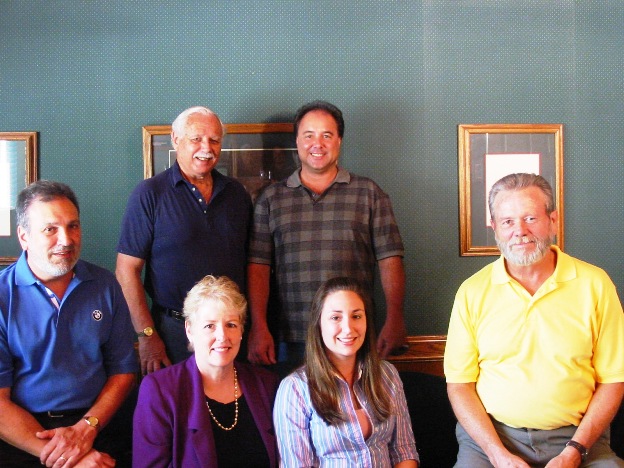
The SpllitMasters, from left Tony Ponzo, Mike Celeste, Pat Ponzo, Tony Celeste, Richard Drake and Jessica Eide.
For husband and wife Tony and Pat Ponzo and the father and son team of Mike and Tony Celeste, they don’t care if the market goes up, down or sideways. Although they live in San Dimas, Calif., 3,000 miles from Wall Street, their stock market picks and strategies, which they share with thousands of subscribers through www.splitmaster.com, have shown consistent double-digit and even triple digit returns.
Although hard to believe in our post-Bernie Madoff world, their basic or conservative “Indicators” strategy for 2011, which has been amazingly accurate in predicting the direction of the overall market on the next trading day, showed a 73% return through February 18 while their aggressive strategy has returned 67%. In 2010, their overall return was 66%; for 2009, 79%; for 2008, 79%.
For their Momentum Strategy, involving “put” and “call” options in which day-traders bet whether the market or a particular stock is going down or up, the results are even more impressive. For 2011, the basic Momentum strategy has shown a 74.9% return and the aggressive Momentum strategy has produced a whopping 336.52% return. For 2010, the returns were 285.32% and 872.42%; for 2009, 571.33%; for 2008, 113.65%.
When Mike, Pat and the two Tony’s formed the SplitMaster.com Strategies in 1997, they were strictly focused on stock splits. Historically, companies that split their stock (example: a 2-for 1 split of I00 shares of IBM stock at $100 becomes 200 shares of IBM stock at $50) outperform popular market indices like Standard & Poor’s because the lower price often attracts more buyers, which in turn begins to drive up the price. Also, companies that split their stock are usually doing well in both growth and profit.
Frequent stock splits at companies like IBM, Microsoft and Wal-Mart made millionaires out of the mom-and-pop variety of buy-and-hold investors. With the 2008 stock market crash and the penchant for companies like Google to see their stock ride ever higher into an elite stratosphere, however, the traditional stock splits almost disappeared from the market. (The good news is, starting in December of 2010 stock splits have come back in a strong way, and SplitMaster and their members have been reaping the benefits.)
In response, the investment group expanded their strategy and reprogrammed their computer for the sexier, but more volatile world of day trading, weighing earnings reports, resistance and support points, and historical performance, among a bushel of factors that can cause a stock to rise or fall.
They had the chops to do it because Mike is a former teacher and his son is a programming wizard. Meanwhile, Tony and Pat ran a successful medical claims company for many years, so marketing and daily number-crunching fit right in with their existing executive talents.
That decision to enter the volatile world of options trading may have been their best yet.
“We aim to make a 7% gain each day,” Mike said, “but even if it were just 7% a week, what’s that? Fifty times seven, that’s 350% for the year.”
Everyone gets up well in advance of the market open at 6:30 a.m., Pacific Time. Most of the market action takes place from 6:30 a.m. to 8:30 a.m. before the market starts to flatten out. In those precious two hours, they make their living.
“It’s very exhausting,” Tony admitted, who has a predilection for Italian cooking and all things “Beatles” when he’s not immersed in the market.
“There are days I go jogging with my dog and I feel like I can go 10 miles and never touch the ground,” he said, when the market confirms the group’s predictions. “Then there are other days, where I can’t get myself out of bed.”
Fotunately, those bedridden slumbers are far fewer than his jogs around the block. Early on, Tony and company took their investment lumps until slowly refining their strategies, techniques and tactics. SplitMaster.com is not a brokerage, but rather a research group. They don’t make stock recommendations; rather, they simply share their investment plays with their subscribers, who are online with them shadowing their investment moves.
In effect, SplitMaster.com tries to find gaps in the market, where companies have been oversold or overbought. Based on their analytics, they get in and get out when they hit the number they’re looking for, and rarely hold trades over for a second day. Every move is transparent to their subscribers. In fact, they are regularly alerted (pinged) about upcoming plays because timing, of course, is critical.
Discipline may be even more important. “What is hard about day-trading is the emotion and the timing,” said Mike, whose thatch of gray hair belies his usual youthful optimism.
SplitMaster.com is focused on educating consumers about the stock market in general, and options trading, in particular. Toward that goal, Tony Ponzo, Mike and Pat are putting the finishing touches on a 200-page tome on investing that will cover everything from basic investing terminology to advanced options trading. In fact, an investor can’t engage in options trading unless approved by his or her broker.
“The truth is,” Tony said, “options are designed to screw the simple options trader. When you learn enough, you try to get to that side that is trying to screw you and ride that side to your advantage – and that’s the key to options.”
Truth in investing … what a novel concept!
But SplitMaster.com seems to be filling that small niche nicely. To learn more about SplitMaster.com or its subscription rates (including a money-back guarantee), visit the Web site, where you’ll find complete and comprehensive information about the group’s different investing strategies, past investment performance, and a number of educational links, like the Chicago Boards Options Exchange, which will send you a free booklet on options trading.
Or you could just wait for their book, which is based on lots of early-morning toil and carefully calibrated, fine-tuned trades.



Leave a Reply